Locating Electrified Aircraft Service to Reduce Urban Congestion
Abstract
:1. Introduction
2. Literature Review
- Comprehensive Data Analysis: A pivotal area for expansion is the broadening of data analytical frameworks to include diverse metrics such as traffic congestion patterns [17], environmental impact assessments [18], and socio-economic ramifications of EAA adoption [19]. A multi-faceted analysis will enable a refined understanding of EAA’s benefits and challenges, facilitating informed decision-making.
- Technological Advancements and Regulatory Frameworks: The rapid evolution of EAA technology [6], coupled with the dynamic regulatory landscape [20], necessitates ongoing research into the operational capabilities, safety standards, and airspace management policies governing EAA. Airspace management emerges as a critical concern, necessitating clear guidelines to ensure the safe integration of EAA with manned aircraft and other drones. Regulatory bodies must develop and enforce safety standards specific to autonomous flight operations. Addressing these considerations is crucial for integrating EAA into existing urban freight systems while ensuring public safety and compliance with aviation regulations [21].
- Economic Viability and Impact Analysis: Assessing the economic implications of transitioning to EAA cargo shuttles is vital. This includes analyzing the economic interplay with trucking [22] and considering factors such as infrastructure investment [23], operational costs [24], and potential economic benefits derived from reduced urban congestion and pollution [25].
- Real-world Applications and Pilot Programs: Insights from EAA pilot programs and case studies are invaluable for bridging the gap between theoretical research and practical implementation. Initial pilot deployments emphasize the need for further research into optimizing EAA operational parameters such as payload capacity, energy consumption, and routing algorithms, to fully exploit their potential in urban logistics systems. These real-world examples can highlight operational challenges, scalability issues, and the overall effectiveness of EAA in diverse urban contexts, serving as critical benchmarks for broader adoption [26]. Strategies to address these deployment challenges include engaging stakeholders early in the planning process, phased testing and deployment of EAA services to build public trust, and leveraging public-private partnerships to fund infrastructure and technology development.
- Integration with Urban Logistics Infrastructure: The synergy between EAA and urban logistics infrastructure, such as fulfillment centers, represents a promising avenue for enhancing last-mile delivery efficiency [27]. Investigating the optimal integration of these systems can further reduce reliance on ground transportation and streamline urban freight operations.
3. Methodology
4. Results and Discussions
5. Conclusions
Funding
Institutional Review Board Statement
Informed Consent Statement
Data Availability Statement
Conflicts of Interest
References
- Poo, M.C.-P.; Lau, Y.-Y.; Qi, B.; Pun, C.F.-K. Sustainable Ground Transportation and the E-Commerce Revolution: Innovations and Challenges at the Intersection. Encyclopedia 2024, 4, 201–214. [Google Scholar] [CrossRef]
- Mendonça, G.D.; Oliveira, S.R.D.M.; Lima, O.F., Jr.; Resende, P.T.V.D. Intelligent algorithms applied to the prediction of air freight transportation delays. Int. J. Phys. Distrib. Logist. Manag. 2024, 54, 61–91. [Google Scholar] [CrossRef]
- Laulederkind, Z.; Peoples, J.H., Jr. Allocative Efficiency in the US Air Cargo Industry. In Urban Economics, Real Estate, Transportation and Public Policy; Cohen, J.P., Ed.; World Scientific Publishing Co Pte Ltd.: Singapore, 2024; pp. 167–196. [Google Scholar]
- IATA. The Value of Air Cargo: Air Cargo Makes It Happen; International Air Transport Association (IATA): Geneva, Switzerland, 2024. [Google Scholar]
- Sakhare, R.S.; Desai, J.; Saldivar-Carranza, E.D.; Bullock, D.M. Methodology for Monitoring Border Crossing Delays with Connected Vehicle Data: United States and Mexico Land Crossings Case Study. Future Transp. 2024, 4, 107–129. [Google Scholar] [CrossRef]
- Bridgelall, R.; Askarzadeh, T.; Tolliver, D.D. Introducing an efficiency index to evaluate eVTOL designs. Technol. Forecast. Soc. Change 2023, 191, 122539. [Google Scholar] [CrossRef]
- Boehm, M.; Arnz, M.; Winter, J. The potential of high-speed rail freight in Europe: How is a modal shift from road to rail possible for low-density high value cargo? Eur. Transp. Res. Rev. 2021, 13, 4. [Google Scholar] [CrossRef]
- FHWA. Freight Analysis Framework Version 5 (FAF5). 14 November 2023. Available online: https://www.bts.gov/faf (accessed on 14 February 2024).
- Rodríguez, Y.; Olariaga, O.D. Air Traffic Demand Forecasting with a Bayesian Structural Time Series Approach. Period. Polytech. Transp. Eng. 2024, 52, 75–85. [Google Scholar] [CrossRef]
- Wolleswinkel, R.E.; Vries, R.D.; Hoogreef, M.; Vos, R. A New Perspective on Battery-Electric Aviation, Part I: Reassessment of Achievable Range. In Proceedings of the AIAA SCITECH 2024 Forum, Orlando, FL, USA, 8–12 January 2024. [Google Scholar]
- Justin, C.Y.; Payan, A.P.; Mavris, D.N. Integrated fleet assignment and scheduling for environmentally friendly electrified regional air mobility. Transp. Res. Part C Emerg. Technol. 2022, 138, 103567. [Google Scholar] [CrossRef]
- Wang, W.; Saari, R.K.; Bachmann, C.; Mukherjee, U. Estimating transboundary economic damages from climate change and air pollution for subnational incentives for green on-road freight. Transp. Res. Part D Transp. Environ. 2020, 82, 102325. [Google Scholar] [CrossRef]
- Correll, D.H. Predicting and understanding long-haul truck driver turnover using driver-level operational data and supervised machine learning classifiers. Expert Syst. Appl. 2024, 242, 122782. [Google Scholar] [CrossRef]
- Pak, H. Use-cases for heavy lift unmanned cargo aircraft. In Automated Low-Altitude Air Delivery: Research Topics in Aerospace; Dauer, J.C., Ed.; Springer: Cham, Switzerland, 2022; pp. 49–72. [Google Scholar]
- Sismanidou, A.; Tarradellas, J.; Suau-Sanchez, P.; O’Connor, K. Breaking barriers: An assessment of the feasibility of long-haul electric flights. J. Transp. Geogr. 2024, 115, 103797. [Google Scholar] [CrossRef]
- Tadić, S.; Krstić, M.; Radovanović, L. Assessing Strategies to Overcome Barriers for Drone Usage in Last-Mile Logistics: A Novel Hybrid Fuzzy MCDM Model. Mathematics 2024, 12, 367. [Google Scholar] [CrossRef]
- Song, C.; Wang, Y.; Wang, L.; Wang, J.; Fu, X. Mapping to cells: A map-independent approach for traffic congestion detection and evolution pattern recognition. Transp. Plan. Technol. 2024, 1–23. [Google Scholar] [CrossRef]
- Li, Y.; Ravi, V.; Heath, G.; Zhang, J.; Vahmani, P.; Lee, S.-M.; Zhang, X.; Sanders, K.T.; Ban-Weiss, G. Air Quality and Public Health Co-benefits of 100% Renewable Electricity Adoption and Electrification Pathways in Los Angeles. Environ. Res. Lett. 2024, 19, 034015. [Google Scholar] [CrossRef]
- Babuder, D.; Lapko, Y.; Trucco, P.; Taghavi, R. Impact of emerging sustainable aircraft technologies on the existing operating ecosystem. J. Air Transp. Manag. 2024, 115, 102524. [Google Scholar] [CrossRef]
- Bendarkar, M.V.; Harrison, E.; Fields, T.M.; Glinski, S.; Garcia, E.; Mavris, D.N. An Extended MBSE Framework for Regulatory Analysis of Aircraft Architectures. In AIAA AVIATION 2023 Forum; American Institute of Aeronautics and Astronautics, Inc.: San Diego, CA, USA, 2023. [Google Scholar]
- Mühlhausen, T.; Peinecke, N. Capacity and workload effects of integrating a cargo drone in the airport approach. In Automated Low-Altitude Air Delivery: Towards Autonomous Cargo Transportation with Drones; Dauer, J.C., Ed.; Springer: Cham, Switzerland, 2022; pp. 449–461. [Google Scholar]
- Bunahri, R.R.; Supardam, D.; Prayitno, H.; Kuntadi, C. Determination of Air Cargo Performance: Analysis of Revenue Management, Terminal Operations, and Aircraft Loading (Air Cargo Management Literature Review). Dinasti Int. J. Manag. Sci. 2023, 4, 833–844. [Google Scholar]
- Cox, J.; Harris, T.; Krah, K.; Morris, J.; Li, X.; Cary, S. Impacts of Regional Air Mobility and Electrified Aircraft on Airport Electricity Infrastructure and Demand; National Renewable Energy Laboratory: Washington, DC, USA, 2023.
- Clarke, M.A.; Alonso, J.J. Forecasting the Operational Lifetime of Battery-Powered Electric Aircraft. J. Aircr. 2023, 60, 47–55. [Google Scholar] [CrossRef]
- Eaton, J.; Naraghi, M.; Boyd, J.G. Market capabilities and environmental impact of all-electric aircraft. Transp. Res. Part D Transp. Environ. 2023, 124, 103944. [Google Scholar] [CrossRef]
- Elwakeel, A.; Ertekin, E.; Elshiekh, M.; Iftikhar, M.; Yuan, W.; Zhang, M. Protection system architecture for all-electric aircraft. IEEE Trans. Appl. Supercond. 2023, 33, 5. [Google Scholar] [CrossRef]
- Lamb, J.S.; Wirasinghe, S.C.; Waters, N.M. Planning delivery-by-drone micro-fulfilment centres. Transp. A Transp. Sci. 2024, 20, 2107729. [Google Scholar] [CrossRef]
- USCB. Commodity Flow Survey Geographies 2017. 8 October 2021. [Online]. Available online: https://www.census.gov/programs-surveys/cfs/technical-documentation/geographies.html (accessed on 13 February 2022).
- BTS and USCB. 2017 Commodity Flow Survey Methodology; U.S. Department of Transportation, Bureau of Transportation Statistics (BTS), and U.S. Department of Commerce, U.S. Census Bureau: Washington, DC, USA, 2020.
- BTS and USCB. 2017 Commodity Flow Survey Standard Classification of Transported Goods (SCTG); Bureau of Transportation Statistics and U.S. Census Bureau: Washington, DC, USA, 2015.
- FHWA. Compilation of Existing State Truck Size and Weight Limit Laws; United States Department of Transportation (USDOT), Federal Highway Administration (FHWA): Washington, DC, USA, 2015.
- FreightWaves. How Much Weight Can a Big Rig Carry? FreightWaves: Chattanooga, TN, USA, 2020. [Google Scholar]
- Kulisch, E. Fed up with Cargo Congestion, Freight Forwarders Flee O’Hare Airport; FreightWaves: Chattanooga, TN, USA, 2021. [Google Scholar]
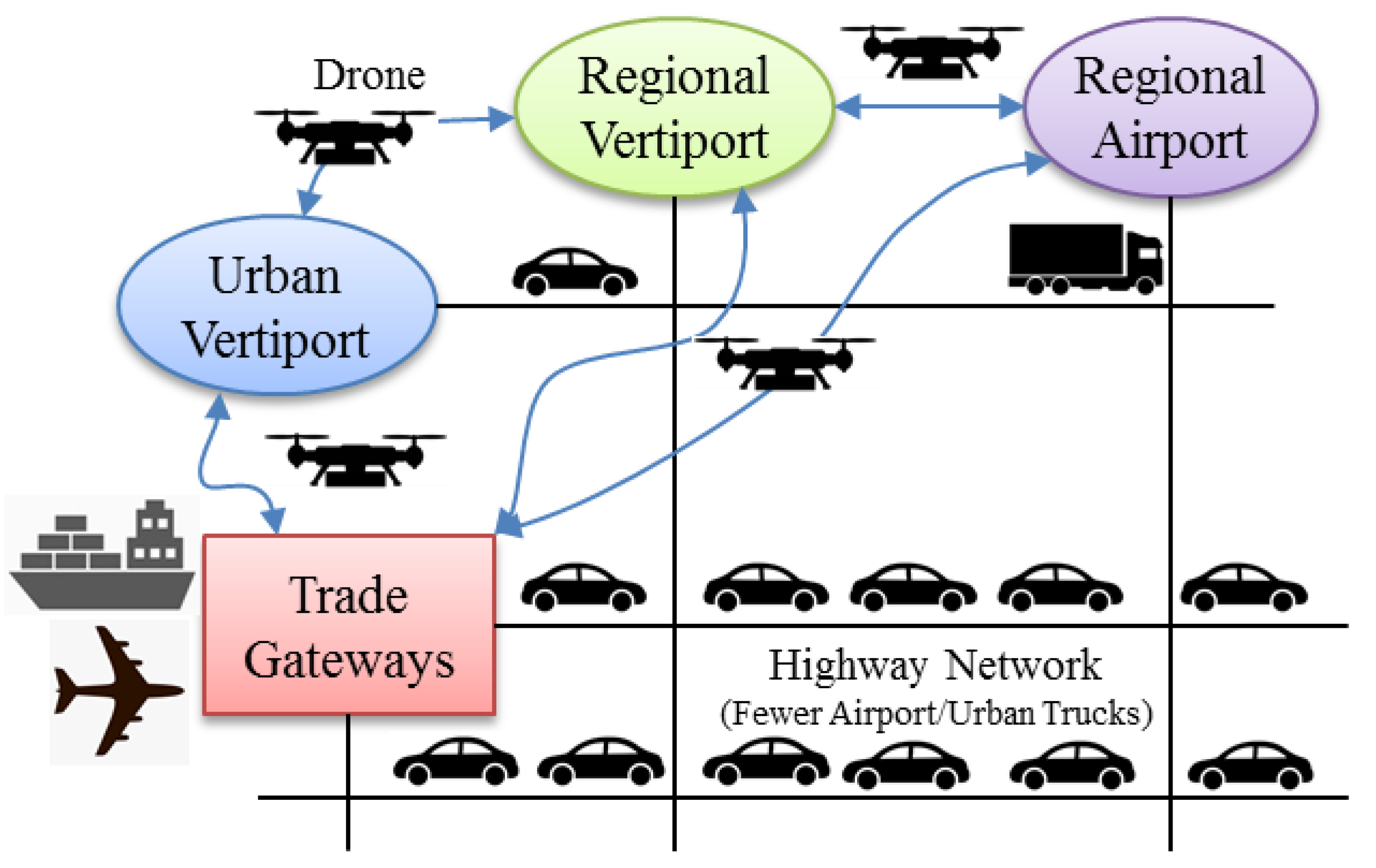
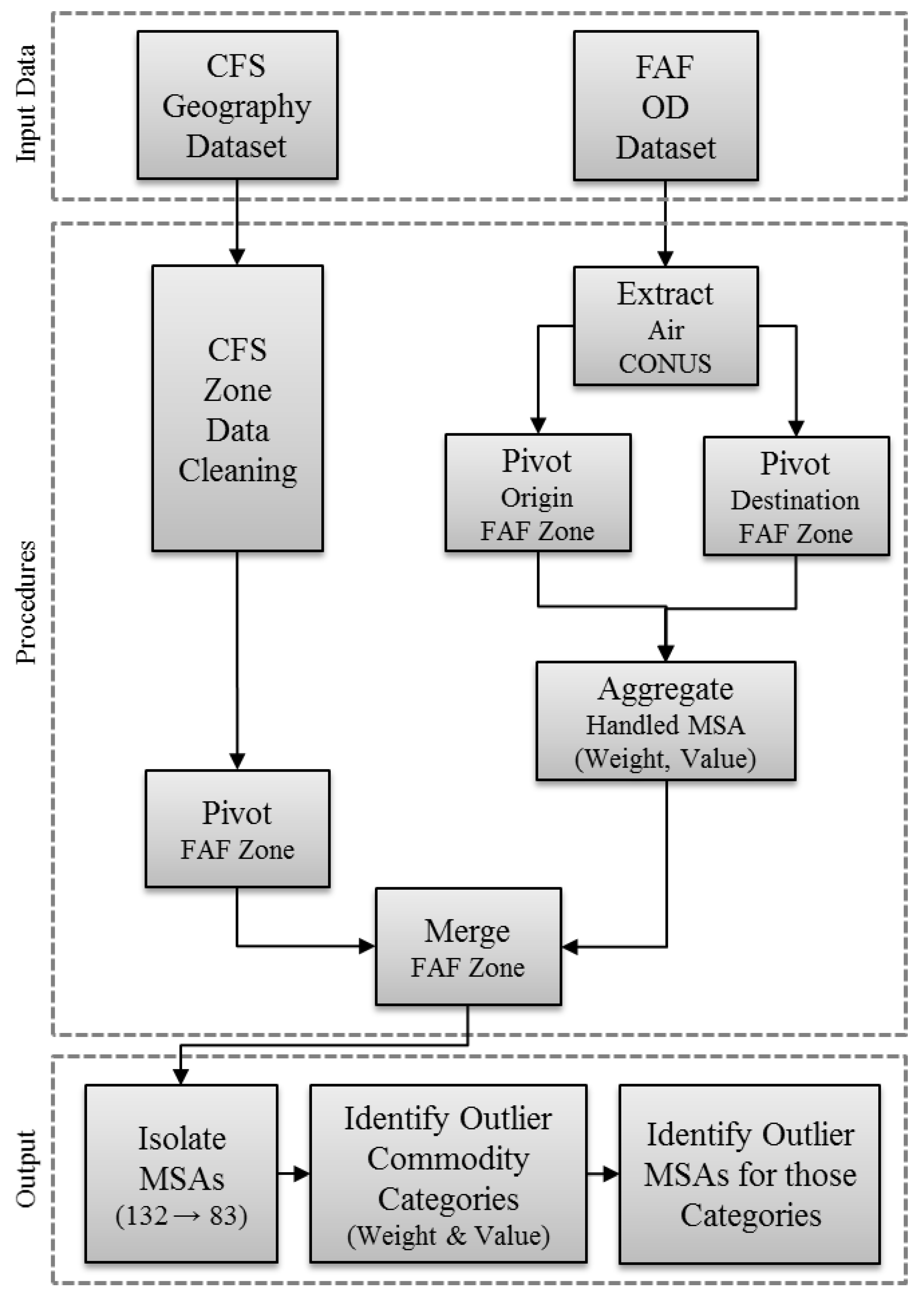
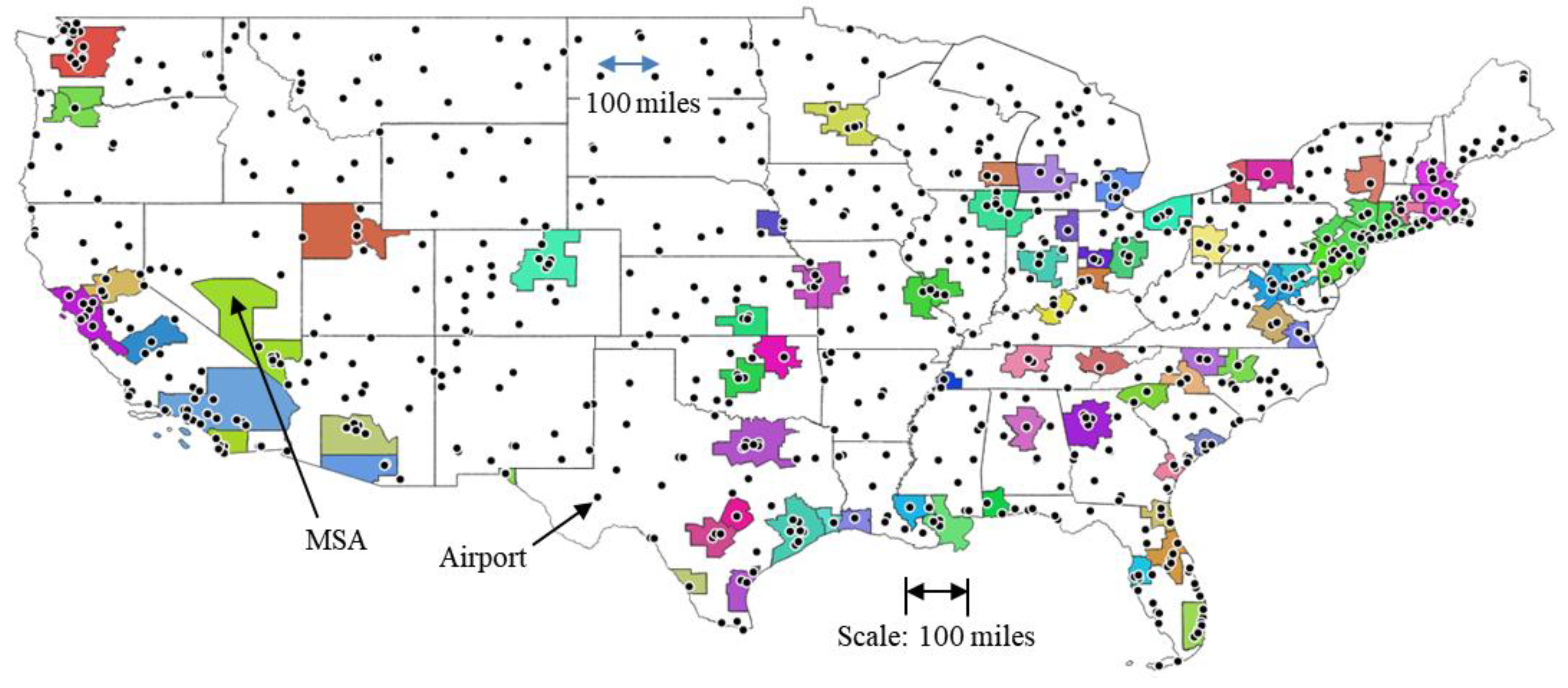

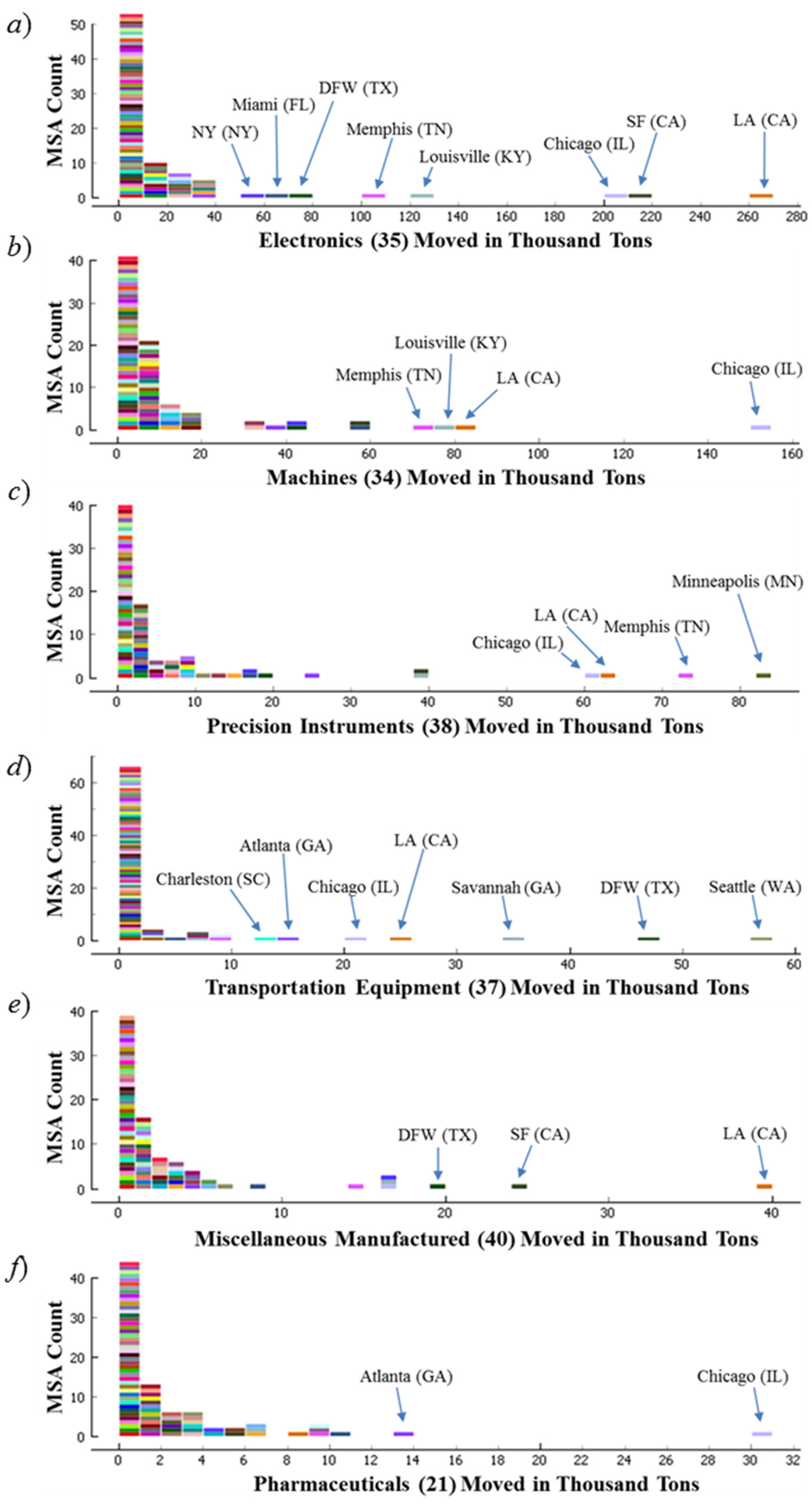
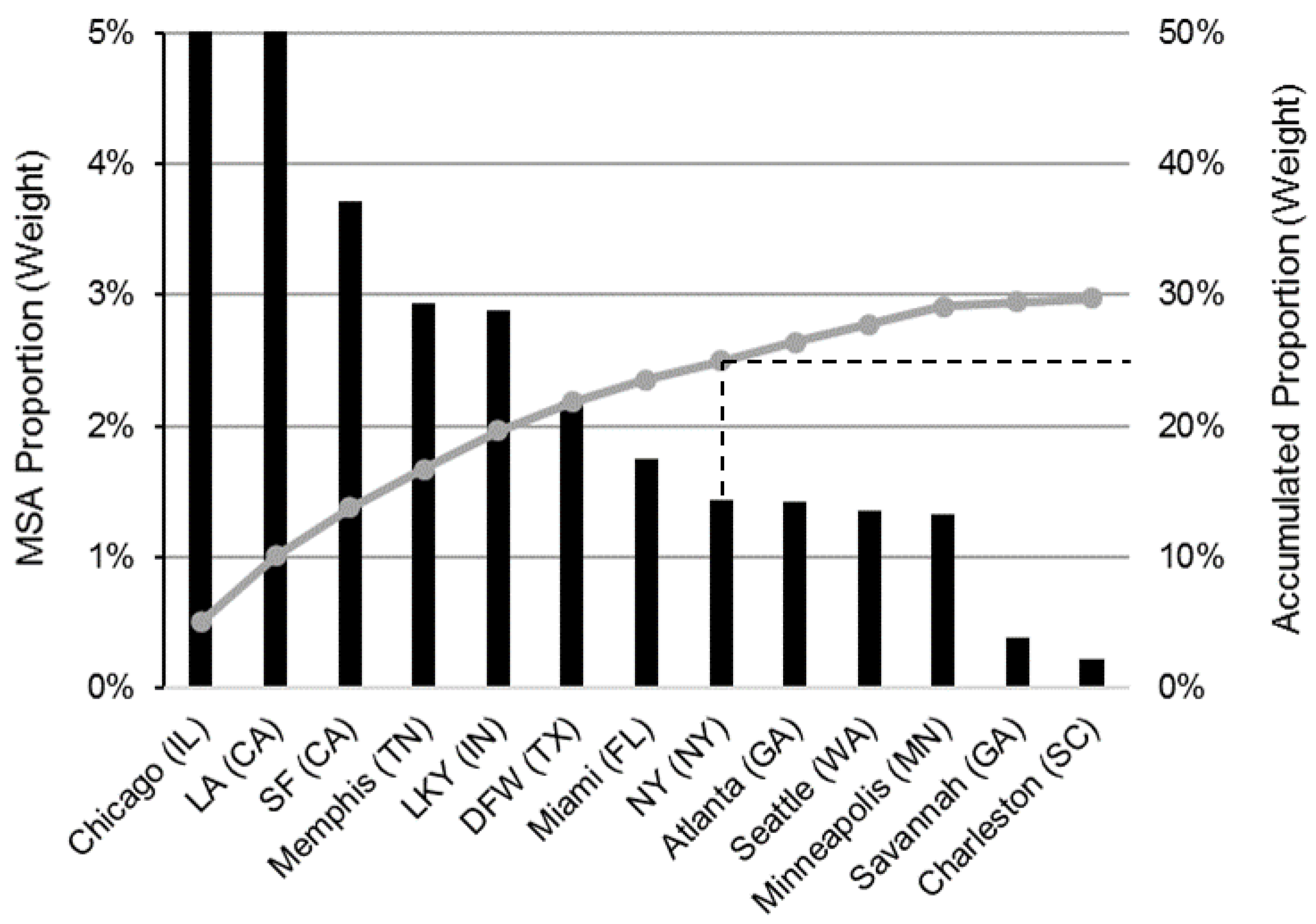
| MSA | Electronics | Machines | Precision Instruments | Transportation Equipment | Misc. Manufactured | Pharma. | Sum (Thousand Tons) | Semitrailer Equivalent |
|---|---|---|---|---|---|---|---|---|
| Chicago (IL) | 200.1 | 151.3 | 60.7 | 20.5 | 16.5 | 30.3 | 479.2 | 21,299 |
| Los Angeles (CA) | 262.6 | 81.0 | 62.6 | 24.0 | 39.2 | 8.7 | 478.2 | 21,251 |
| San Francisco (CA) | 218.4 | 59.3 | 38.5 | 7.0 | 24.2 | 5.3 | 352.7 | 15,674 |
| Memphis (TN) | 100.2 | 71.2 | 73.4 | 8.7 | 15.0 | 9.9 | 278.3 | 12,371 |
| Louisville (KY) | 124.0 | 77.8 | 39.6 | 7.9 | 16.9 | 6.9 | 273.2 | 12,141 |
| DFW (TX) | 78.9 | 40.6 | 18.6 | 46.2 | 19.9 | 2.7 | 206.9 | 9197 |
| Miami (FL) | 69.9 | 55.5 | 17.4 | 4.8 | 8.3 | 10.2 | 166.0 | 7378 |
| New York (NY) | 54.9 | 41.6 | 16.3 | 3.5 | 16.5 | 4.0 | 136.8 | 6082 |
| Atlanta (GA) | 39.8 | 38.1 | 24.5 | 14.7 | 4.8 | 13.4 | 135.4 | 6016 |
| Seattle (WA) | 31.9 | 18.4 | 10.1 | 57.7 | 6.7 | 3.6 | 128.3 | 5704 |
| Minneapolis (MN) | 22.3 | 15.7 | 82.1 | 1.0 | 3.3 | 2.2 | 126.5 | 5623 |
| Savannah (GA) | 0.8 | 0.7 | 0.5 | 34.6 | 0.1 | 0.1 | 36.8 | 1635 |
| Charleston (SC) | 2.8 | 2.2 | 1.2 | 13.5 | 0.7 | 0.5 | 20.8 | 926 |
Disclaimer/Publisher’s Note: The statements, opinions and data contained in all publications are solely those of the individual author(s) and contributor(s) and not of MDPI and/or the editor(s). MDPI and/or the editor(s) disclaim responsibility for any injury to people or property resulting from any ideas, methods, instructions or products referred to in the content. |
© 2024 by the author. Licensee MDPI, Basel, Switzerland. This article is an open access article distributed under the terms and conditions of the Creative Commons Attribution (CC BY) license (https://creativecommons.org/licenses/by/4.0/).
Share and Cite
Bridgelall, R. Locating Electrified Aircraft Service to Reduce Urban Congestion. Information 2024, 15, 186. https://doi.org/10.3390/info15040186
Bridgelall R. Locating Electrified Aircraft Service to Reduce Urban Congestion. Information. 2024; 15(4):186. https://doi.org/10.3390/info15040186
Chicago/Turabian StyleBridgelall, Raj. 2024. "Locating Electrified Aircraft Service to Reduce Urban Congestion" Information 15, no. 4: 186. https://doi.org/10.3390/info15040186
APA StyleBridgelall, R. (2024). Locating Electrified Aircraft Service to Reduce Urban Congestion. Information, 15(4), 186. https://doi.org/10.3390/info15040186







